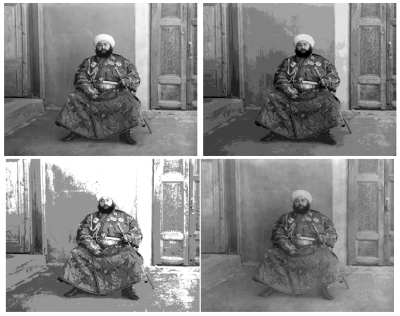TR2005-083
Why I Want a Gradient Camera
-
- , "Why I Want a Gradient Camera", IEEE Conference on Computer Vision and Pattern Recognition (CVPR), June 2005, vol. 1, pp. 103-110.BibTeX TR2005-083 PDF
- @inproceedings{Tumblin2005jun,
- author = {Tumblin, J. and Agrawal, A. and Raskar, R.},
- title = {{Why I Want a Gradient Camera}},
- booktitle = {IEEE Conference on Computer Vision and Pattern Recognition (CVPR)},
- year = 2005,
- volume = 1,
- pages = {103--110},
- month = jun,
- issn = {1063-6919},
- url = {https://www.merl.com/publications/TR2005-083}
- }
- , "Why I Want a Gradient Camera", IEEE Conference on Computer Vision and Pattern Recognition (CVPR), June 2005, vol. 1, pp. 103-110.
-
Research Area:

Abstract:
We propose a camera that measures static gradients instead of static intensities. Quantizing sensed intensity differences between adjacent pixel values permits an ordinary A/D converter to measure detailed high contrast (HDR) scenes. We measure alternating 'cliques' of sensors (small groups) that locally determine their own best exposure and reconstruct the image using a Poisson solver. This intrinsically differential design suppresses common-mode noise, hides and smoothes quantizaiton, and can correct for its own saturated sensors. Simulations demonstrate these capabilities in side-by-side comparisons.
Related News & Events
-
NEWS CVPR 2005: 5 publications by Matthew Brand, Ramesh Raskar and Jeroen van Baar Date: June 20, 2005
Where: IEEE Conference on Computer Vision and Pattern Recognition (CVPR)
MERL Contact: Matthew BrandBrief- The papers "A Direct Method for 3D Factorization of Nonrigid Motion Observed in 2D" by Brand, M., "Integral Histogram: A Fast Way to Extract Histograms in Cartesian Spaces" by Porikli, F., "Why I Want a Gradient Camera" by Tumblin, J., Agrawal, A. and Raskar, R., "Videoshop: A New Framework for Spatio-Temporal Video Editing in Gradient Domain" by Wang, H., Xu, N., Raskar, R. and Ahuja, N. and "Handheld Projectors for Mixing Physical and Digital Textures" by Beardsley, P., Forlines, C., Raskar, R. and van Baar, J. were presented at the IEEE Conference on Computer Vision and Pattern Recognition (CVPR).